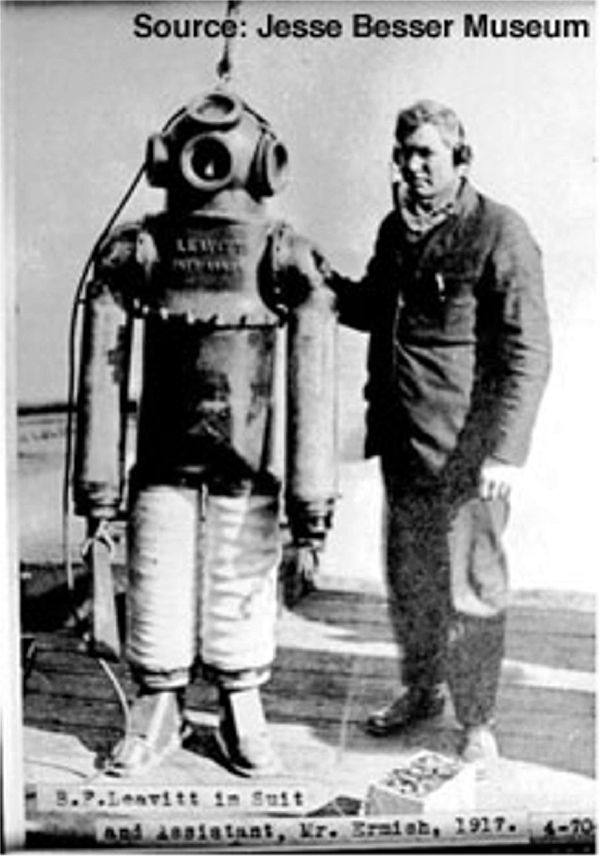|
Al information about Leavitt and his Salvage company shows that Mr. Leavitt seems to be more a commercial man than an actual diver. The stories written about him are all about money, and many times when the moment of truth was there, plans were changed. In the book of Gary L. Harris " Ironsuit " you can find detailed information about the man. ( ISBN 0-941332-25X 1994). |
|
Although many stories are in a way negative, Leavitt had patents, a
salvage company, an actual build a atmospheric suit and an undersea
lamp. (building the actual suit is a rare practise in the world of
atmospheric diving science. Most suits where build in the minds of
great inventors ;) ) He managed to be in the news many times and was very successful in getting famous with his stories. Many people invested in his projects. |
| Leavitt patent for his diving suit: US Patent 1327679 |
| Leavitt patent for his deep sea light US patent 1611651 |
 |
|
This very unique picture shows the Leavitt suit and deepdiving lamp when used in Chili ! Copyright Life, Topical Press Agency, Getty_Imaes |
|
Time magazine 26-01-1925;
Although earth and rock are much harder substances than water, the
depths of the earth have been much easier for man to reach than the
depths of the water. For, although a solid is harder to penetrate
initially than a fluid, once penetrated, there is a hole which
offers no subsequent resistance, whereas a fluid always exerts a
pressure, increasing with depth. So it happens that, although man
has been down in the earth for many thousands of feet, no diver had
ever until recently been down more than about 30 fathoms (180 ft.)
below the surface of the sea.
But there was a Captain Benjamin Leavitt, who was not content that this paltry 30
fathoms should be set as a lower limit to his activities. In 1922 he
bought a ship, the Blakely,
from the Shipping Board. He fitted her out for diving and salvaging,
and laid in an equipment of
patent diving suits of manganese bronze (which resists salt
water corrosion), with flexible parts of interlocking copper tubing
and ball bearing joints, with portable air equipment, carrying a
four-hour supply of oxygen and a telephone.
During the winter of 1923 a visit was made to the west coast of
Chile. There, two miles off Pichidangui, was located the wreck of
the British schooner Cape
Horn, which went down in 1869 with a cargo of copper, lying in
53 fathoms (318 ft.) of water. Captain Leavitt declares that in some
of his searches he went down to 60 fathoms (360 ft.). When the wreck
was discovered, a difficulty came up. At 53 fathoms it was almost
pitch dark; there was not enough light to work by.
So a return was made to the U. S. and special lights were, procured,
incandescent vacuum lamps, with glass capable of resisting ten
times; normal air pressure, made by the Westinghouse Lamp Co. With
these, the expedition set out in the Blakely just a year ago. Work
was begun in March. Last week, messages were received telling that
$600,000 worth of copper had successfully been salvaged from the
Cape Horn.
The success of this feat suggests that it may be possible to salvage
between $4,000,000 and $6,000,000 in gold and valuables that sank
with the Lusitania. The Lusitania, sunk by a German submarine in
1915, lies in 42 fathoms of water off the southern coast of Ireland.
It opens up vistas of salvaging sunken Spanish argosies with their
almost legendary treasures.
Even if the success of the present expedition has doubled the former
range of practical diving from 30 to 60 fathoms, the fact remains
that divers have barely scratched the epidermis on Father Neptune's
back, with its average depth of 2ľ miles. |
|
As World War I fostered a copper shortage, Margaret C. Goodman
gained attention by organizing a salvage expedition in 1917. She
entered the business in order to support an invalid husband and a
daughter. Goodman employed diver Benjamin Franklin Leavitt, who used
a new type of diving suit capable of descending to 300 feet. The
endeavor brought up more than 100 tons of copper and iron ore. Other
mementos were raised from the ship, including watches, revolvers,
coins predating the Civil War, bracelets, spectacles, books, ladies'
hair combs, gentlemen's square-toed boots, slippers, handmade silk
lace, baggage-room checks and door keys stamped with Pewabic's name.
No trace was found of the fabled silver-filled kegs.
|
 |
 |
 |
 |
 |
 |
 |
 |
 |
| Courtesy JesseBesser Museum |
| After his adventures and Salvaging operations not much was heart about Mr. Leavitt anymore. I would be very pleased to know more about him, so if you have any additional information please send it to me! |
| May 2009 |
| Please sign my Guestbook |
| Email: jw.bech@quicknet.nl |
Benjamin Franklin Leavitt build another revival of spiral armouring like Buchanan and Gordon. The radius pieces of the flexible arms and legs add to the resemblance. In this case, however, the spirals form both armouring and covering, after the fashion of a flexible metallic voice pipe. Its utility under heavy pressure is questionable. The air supply is self contained.
Menu Atmospheric suits
Updates
Speedmenu
Search page
Webshop
Home
GO BACK TO
ATMOSPHERIC
DIVING SUITS.
Mainmenu:
Search this Website
Information about RB
Photo galleries
Historical Information
Links & Downloads
Reviews
Homebuilders
Electronics
Updates, speed menu
Web shop
Reviews SC rebreathers
Reviews CC rebreathers
RBís through the ages
Inspiration rebreather
Database Oxygen RBís
Database Semiclosed RBís
Updates
Speed menu
Search this web
